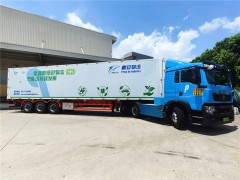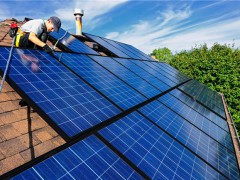據(jù)美國鉆井網(wǎng)站報道,亞太地區(qū)將繼續(xù)引領(lǐng)全球電力市場的增長,在未來十年里為可再生能源增長創(chuàng)造1.8萬億美元的機會。
能源咨詢公司伍德麥肯茲表示,在過去20年里,亞太地區(qū)的電力需求增長了200%。2021年,亞太地區(qū)的電力需求上升到全球總需求的近一半,市場擴大了了6.5%——遠(yuǎn)遠(yuǎn)超過世界其他地區(qū)。
到2040年前,亞太地區(qū)的電力需求將平均年增長2.5%,幾乎是其他地區(qū)的兩倍。由于化石燃料重要性的下降和亞太地區(qū)的脫碳,太陽能和風(fēng)能將有巨大增長的機會。但即使電力需求攀升,電價飆升,可再生能源開發(fā)商面臨的風(fēng)險也在增加,供應(yīng)鏈、緊縮、融資和政策風(fēng)險都在上升。更不確定的是,在爆發(fā)地緣政治沖突后,天然氣和液化天然氣的前景發(fā)生了顯著變化。
與其他地區(qū)一樣,亞太地區(qū)的發(fā)電成本正在上升。自去年第二季度以來,LNG、煤炭、燃料油和柴油價格都大幅上漲。
總的說來,未來3年亞太地區(qū)的發(fā)電成本每年將達(dá)到6500億美元,比去年增加三分之二。最終用戶將承受電價上漲的沖擊,電價將上漲27%,到2025年的未來3年,總費用將增加1.7萬億美元。
在價格上漲的支持下,亞太地區(qū)的電力市場將在未來十年吸引2.9萬億美元的投資。可再生能源將成為主要受益者:所需投資的60%(或1.8萬億美元)將流向清潔能源。 風(fēng)能和太陽能將占據(jù)最大份額。
同時,到2050年前,化石燃料在能源結(jié)構(gòu)中的占比將從現(xiàn)在的67%逐漸下降到不足三分之一。 許多成長型市場仍然依賴煤炭,但隨著整個地區(qū)的脫碳目標(biāo)已經(jīng)確定,重點正在轉(zhuǎn)向可再生能源。
伍德麥克茲相信有巨大的機會,但也看到挑戰(zhàn)在增加。隨著供應(yīng)鏈和融資成本的上升以及電網(wǎng)整合問題的惡化,可再生能源開發(fā)商面臨的風(fēng)險越來越大。縮減開支也對收入構(gòu)成風(fēng)險。到2030年前,一些市場的太陽能和風(fēng)能裝機容量將達(dá)到電網(wǎng)峰值負(fù)荷的90%。然而在儲能方面的投資還不夠——到本十年結(jié)束時,儲能水平將僅為電網(wǎng)峰值負(fù)荷的15%。
考慮到可再生能源的全部成本——包括傳輸、電池存儲和天然氣峰值儲備裝置——它們目前在亞太地區(qū)無法與煤炭競爭。
盡管如此,亞太地區(qū)的發(fā)展方向是明確的。未來10年,亞太地區(qū)新增年發(fā)電能力平均將達(dá)到327吉瓦,其中太陽能和風(fēng)能將達(dá)到200吉瓦。
李峻 編譯自 油價網(wǎng)
原文如下:
Renewables In Asia Pacific A $1.8 Trillion Opportunity
Asia Pacific continues to set the pace for power market growth, creating a $1.8 trillion opportunity for renewables in the next decade.
Wood Mackenzie said that Asia Pacific has had a 200% increase in power demand over the past two decades. Power demand in the region rose to nearly half the global total in 2021, as the market expanded by 6.5% – far outpacing the rest of the world.
By 2040, APAC’s power demand growth will average 2.5%, nearly double the rate of other regions and there will be huge opportunities for solar and wind as fossil fuels decrease in importance and the region decarbonizes. But even as demand for electricity climbs and power prices soar, risks to renewables developers are mounting with supply chain, curtailment, financing, and policy risks on the rise. Adding more uncertainty, the outlook for gas and LNG has changed significantly in the wake of the war .
As in other regions, Asia Pacific’s power generation costs are going up. LNG, coal, fuel oil, and diesel prices have all dramatically increased since the second quarter of 2021.
Overall, generation costs will be $650 billion more each year for the next three years – a two-thirds increase in 2021 numbers. End users will bear the brunt of these hikes, with power set to be 27% more expensive, or a total of $1.7 trillion more over the next three years to 2025.
Supported by price inflation, Asia Pacific’s power market sector will attract $2.9 trillion in investment in the next decade. Renewables will be a major beneficiary: 60% of the investments – or $1.8 trillion – needed will go into clean energy. Wind and solar will make up the lion’s share.
Meanwhile, fossil fuels will decline gradually from 67% of the power mix today to less than a third by 2050. Many growth markets still rely on coal – but with decarbonization targets now set across the region, the emphasis is on shifting to renewables.
Woodmac believes that there were huge opportunities to play for, but also sees that the challenges were mounting.
Renewable developers are increasingly exposed to risk as supply chain and financing costs rise and grid integration issues worsen. Curtailment also poses a risk to revenue. Solar and wind capacity is heading towards 90% of peak grid load in some markets by 2030. And not enough is being invested in storage – by the end of this decade, storage levels will only be at 15% of peak grid load.
Considering the full costs of renewables – including transmission, battery storage, and gas peaker reserve units – they are not currently competitive with coal in the region.
Nonetheless, the direction of travel is clear. Asia Pacific will add an average of 327 GW/year of new power generation capacity in the next decade, with solar and wind hitting 200 GW/year.
免責(zé)聲明:本網(wǎng)轉(zhuǎn)載自其它媒體的文章及圖片,目的在于弘揚石化精神,傳遞更多石化信息,宣傳國家石化產(chǎn)業(yè)政策,展示國家石化產(chǎn)業(yè)形象,參與國際石化產(chǎn)業(yè)輿論競爭,提高國際石化產(chǎn)業(yè)話語權(quán),并不代表本網(wǎng)贊同其觀點和對其真實性負(fù)責(zé),在此我們謹(jǐn)向原作者和原媒體致以崇高敬意。如果您認(rèn)為本站文章及圖片侵犯了您的版權(quán),請與我們聯(lián)系,我們將第一時間刪除。







